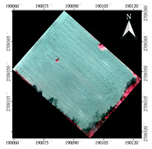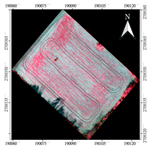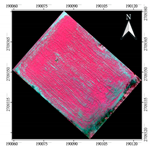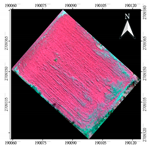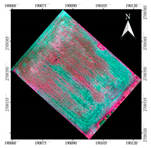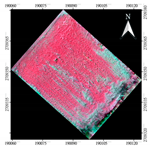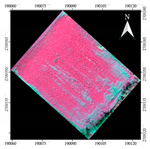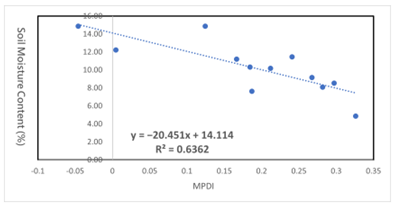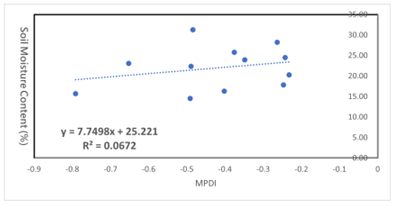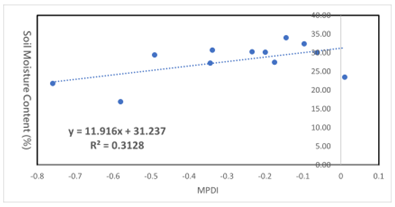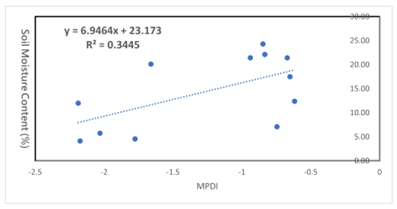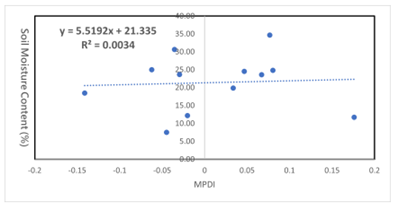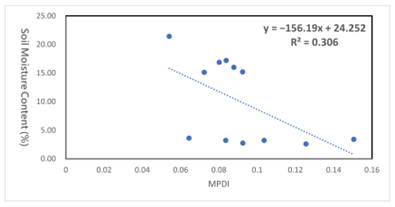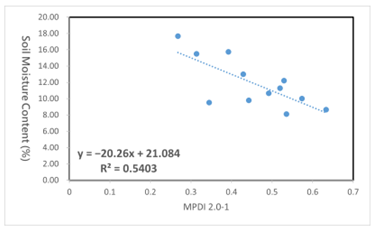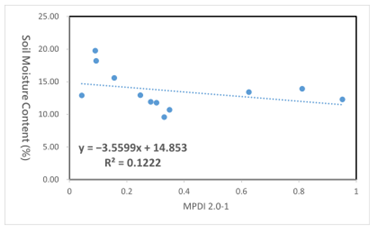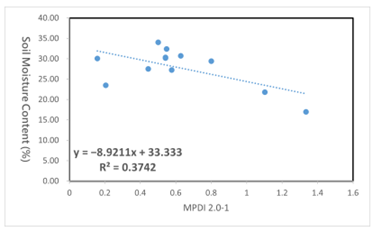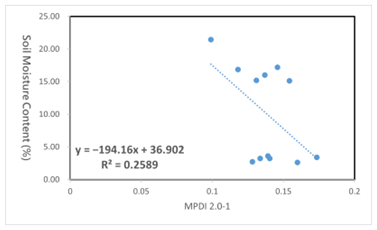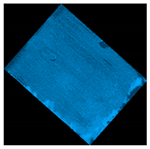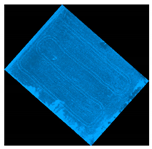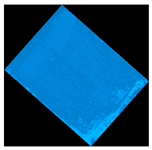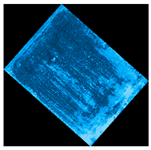Abstract
This study aimed to address the challenge of monitoring and managing soil moisture in dryland agriculture with supplemental irrigation under increasingly extreme climate conditions. Using unmanned aerial vehicles (UAVs) equipped with hyperspectral sensors, we collected imagery of wheat fields on Kinmen Island at various growth stages. The Modified Perpendicular Drought Index (MPDI) was calculated to quantify soil drought conditions. Simultaneously, soil samples were collected to measure the actual soil moisture content. These datasets were used to develop a Gradient Boosting Regression (GBR) model to estimate soil moisture across the entire field. The resulting AI-based model can guide decisions on the timing and scale of supplemental irrigation, ensuring water is applied only when needed during crop growth. Furthermore, MPDI values and wheat spike samples were used to construct another GBR model for yield prediction. When applying MPDI values from multispectral imagery collected at a similar stage in the following year, the model achieved a prediction accuracy of over 90%. The proposed approach offers a reliable solution for enhancing the resilience and productivity of dryland crops under climate stress and demonstrates the potential of integrating remote sensing and machine learning in precision water management.
1. Introduction
Dryland fields are cultivation areas characterized by arid soil conditions. Throughout the long history of agricultural production, humans have developed the practice of growing drought-tolerant crops—such as sorghum, wheat, corn, and soybeans—on such lands. These crops can only rely on rainwater resources, and non-uniform rainfall timing and volume affect their growth, consequently influencing the quantity and quality of the harvest. In recent years, climate anomalies have increased the frequency of droughts and heavy rainfall, intensifying reductions in crop yield [1], and the actual crop distribution in much of the world does not maximize agricultural water value [2]. According to Vogel et al. [1], cereal crop yields in dryland areas have declined by up to 15% in extreme drought years. In China, wheat-growing provinces such as Hebei and Henan have reported a 20–30% reduction in output during recent prolonged dry spells. These adverse events not only threaten food security but also highlight the urgent need for adaptive irrigation strategies and precise soil moisture management [1]. Providing timely and moderate irrigation in water-scarce regions is considered an effective way to mitigate this risk and reduce food production losses. The sustainable use of available water resources under water scarcity conditions requires the adoption of water allocation policies favoring conservative and efficient use [3]. Therefore, determining effective irrigation timing and supplying adequate water to meet the growth needs of crops in drylands has become a pressing issue in land use management.
Various methods have been developed for soil moisture monitoring. Ground-based techniques such as time-domain reflectometry (TDR), neutron probes, and gravimetric sampling offer high accuracy but are labor-intensive, spatially limited, and costly for large-scale deployment. In contrast, remote sensing techniques—including optical, thermal infrared, and microwave sensors—enable broader spatial coverage and temporal frequency. For instance, satellite-based systems such as SMAP and Sentinel-1 can provide regional-scale soil moisture estimates, but often at coarse resolutions (>1 km). UAV platforms bridge this gap by offering high spatial resolution (<10 cm) and flexible scheduling, making them particularly suitable for field-scale agricultural applications. However, UAV imagery is still subject to spectral interference from vegetation cover, which our modified MPDI method aims to address.
In this study, information on drought indices and soil moisture variation was collected at different growth stages of crops in dryland fields, aiming to establish an effective mechanism for soil moisture monitoring and regulation. According to the World Reference Base for Soil Resources (WRB) [4], the soil at the study site in Jinsha Township, Kinmen County, is classified as an Eutric Cambisol. This classification is based on the soil’s weakly developed cambic horizon, high base saturation, good drainage, and minimal horizon differentiation. The parent material primarily consists of weathered granite-derived red soils, consistent with the region’s subtropical monsoon climate and granitic terrain. These characteristics make the soil suitable for cultivating drought-tolerant crops under dryland or rainfed agricultural conditions. Given the vast area of dryland farms, traditional manual soil sampling methods are inadequate in providing representative and comprehensive data. In contrast, satellite monitoring lacks sufficient detail to present moisture status at the parcel scale. Thus, this study utilized unmanned aerial vehicles (UAVs) equipped with multispectral sensors to capture multispectral imagery of dryland crops at different growth stages. The imagery was then used to estimate drought indices during the crop growth period and assess the feasibility of using such indices to estimate soil moisture content.
2. Materials and Methods
2.1. Research Site
To achieve the research goals, wheat fields on Kinmen Island were selected as the study area. Located on the southeastern coast of Fujian, China, Kinmen is known for its sorghum liquor, for which wheat serves as an essential ingredient in the fermentation process. The island produces approximately 4100 metric tons of wheat annually. The soil in Kinmen is primarily brick-red clayey sand with a shallow depth, acidic pH, and minimal humus, and it developed from red soil layers. It has good fertility retention and water-holding capacity [5], making it suitable for drought-tolerant coarse grains. Kinmen has a subtropical marine climate with an average temperature of 21 °C. The highest temperature can reach 33 °C in July and August, and the coldest temperature is only around 10 °C from January to March. Rainfall is scarce throughout the year, with an average annual rainfall of less than 1100 mm, and it is unevenly distributed. The rainy season is from February to April each year, and the dry season is from October to February of the following year. The average relative humidity is 79%. There are no high mountains in the territory, so northeast monsoon winds blow directly through the region, and evaporation can exceed 1600 mm, which has a great impact on the growth of crops. According to the average wheat yield data (kg/hectare) from 2012 to 2024, provided by the agricultural unit of the Kinmen County Government, as shown in Figure 1a, the yield is highly variable, and the average yield has shown a downward trend in the past three years. Highly variable rainfall has caused poor wheat ear formation (Figure 1b), which has indirectly led to a decline in yield. Wheat growth is closely linked to soil moisture at each developmental stage [6]. The study fields are classified as dryland farmland, and rainfed agriculture is implemented, but nearby ponds can provide supplementary irrigation. For example, moist but not waterlogged soil is required at sowing, increased irrigation is needed during the jointing and tillering stages, and moderate irrigation is critical from flowering to early grain filling. Therefore, establishing an effective mechanism for monitoring and regulating irrigation water is essential for addressing the challenges posed by extreme climates.
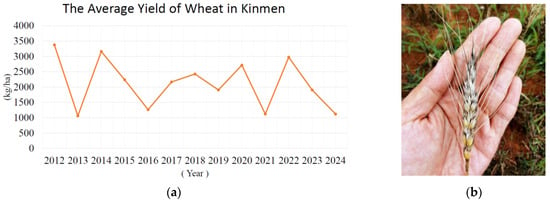
Figure 1.
(a) Line chart of average wheat yield in Kinmen from 2012 to 2024; (b) photo of wheat blackening (Image source: Agricultural Research Institute, Kinmen County).
The study area is a wheat field located at Parcel No. 713 in Jinsha Township, Kinmen County, on Kinmen Island (Figure 2), with an area of approximately 0.2 hectares. The site was chosen primarily for its proximity to a pond, which allows for manual irrigation during crop growth, facilitating the application of future research results. In terms of topographic conditions, the southeastern side of the Parcel No. 713 wheat field is relatively low-lying. During rainfall events, water infiltrates the topsoil and flows toward this area, resulting in higher soil moisture content. This variation in moisture characteristics served as a basis for comparative analysis in the later stages of the study.
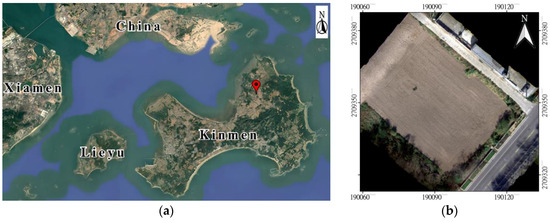
Figure 2.
A map of the study site location: (a) Parcel No. 713 in Jinsha Township, Kinmen County, is located in the upper right area of Kinmen Island; (b) an aerial image of the wheat field at Parcel No. 713.
Although the field is categorized as dryland farmland, its proximity to a pond enables occasional supplemental irrigation. This setting simulates a realistic scenario of rainfed agriculture with limited water availability.
2.2. UAV Remote Sensing Image Data
To obtain multispectral imagery of wheat at various growth stages, this study utilized a spectral sensor equipped with lenses covering the following bands: blue (B: 450 ± 16 nm), green (G: 560 ± 16 nm), red (R: 650 ± 16 nm), red edge (RE: 730 ± 16 nm), and near-infrared (NIR: 840 ± 26 nm). In addition to providing true-color RGB images, the RE and NIR bands are effective for monitoring crop growth in the field. To ensure a fine spatial resolution of 1 cm/pixel, the UAV was operated at a low altitude of 20 m with 85% forward and side overlap. To minimize shadow effects caused by a low solar elevation angle, image acquisition was scheduled between 10:00 AM and 2:00 PM. Ground control points (GCPs) were established around the test field (Figure 3a), and Pix4Dmapper software 4.10 was used to obtain the interior orientation parameters of the sensor. These parameters were integrated with aerial triangulation and GCPs to perform geometric correction, with residual errors required to be less than one pixel (i.e., under 1 cm). The UAV multispectral imagery was collected from December 2021 to April 2022, with a frequency of approximately once every two weeks. A total of eight multispectral images were acquired for Parcel No. 713 (Table 1). Since the data were collected on different dates, variations in the solar angle, light intensity, and atmospheric conditions were considered. Radiometric calibration panels were placed on-site (Figure 3b) to perform relative radiometric correction after image acquisition, ensuring consistency in spectral reflectance for the same ground objects on different dates [7,8]. The processed multispectral images were then used for subsequent calculations and analyses of soil drought indices.

Figure 3.
UAV image correction reference: (a) ground control points (GCPs); (b) radiometric calibration panels.

Table 1.
The eight multispectral images of Parcel No. 713.
2.3. Soil Drought Indices (SDIs)
The Perpendicular Drought Index (PDI) was proposed by Ghulam et al. in 2006 as an indicator for estimating soil drought in bare land areas [9]. The relationship between the PDI and soil moisture can significantly explain the variation in spatial drought patterns [10]. The formula for calculating the PDI is shown in Equation (1). However, it has been pointed out that surface cover types in farmland vary significantly across different crop growth stages, ranging from bare soil to dense vegetation. In regions characterized by non-uniform terrain and various soil types, the performance of the PDI is limited. To address this, a modified version of the index—the Modified Perpendicular Drought Index (MPDI)—was proposed [11], as shown in Equation (2). It has been confirmed that the PDI performs well for bare soil applications or early stages of vegetation growth, while the MPDI is best for vegetated surfaces but still effective for bare soils [12]. In this equation, is used to assess the density of vegetation coverage, ranging from 0 to 1. A value closer to 0 indicates that the soil is nearly bare, while a value closer to 1 indicates higher canopy coverage. Therefore, when = 0, the MPDI becomes equivalent to the PDI. The MPDI incorporates to reduce the influence of the vegetation canopy [13], aiming to retrieve the underlying soil drought condition, as represented by the PDI. Accordingly, this study adopted the MPDI as the soil drought index for Parcel No. 713 throughout the wheat growth period. The formulas are as follows:
where S represents the soil line slope; and denote reflectance in the red and near-infrared bands, respectively; and and represent the reflectance of vegetation in the red and near-infrared bands, respectively. According to the literature, and are constant values, recommended to be 0.05 and 0.5, respectively. NDVI refers to the Normalized Difference Vegetation Index [9,11,14,15].
2.4. In Situ Soil Moisture Monitoring Data
In addition to using multispectral imagery to calculate MPDI values for estimating soil moisture content, it was also necessary to collect soil samples from appropriate field locations at different time points to analyze the in situ soil moisture conditions. Through regression analysis, a correlation equation between MPDI values and soil sample moisture content can be established [16,17]. This correlation can then be applied, together with multispectral imagery obtained at various stages, to estimate the soil moisture distribution across the entire field of Parcel No. 713 at different times, which provides an effective supplementary irrigation mechanism in rainfed agricultural operations. In this study, soil samples were collected from Parcel No. 713 on eight separate dates. For each sampling session, twelve sampling points were uniformly distributed across the field, with a sampling depth of approximately 10 cm. The collected soil samples were then subjected to moisture content analysis. The measurements of soil moisture content at different stages and sampling points are shown in Table 2. Soil sampling was conducted using a handheld sampler, with full consideration of the reasonable distribution of coverage, ensuring that the sampling positions were evenly distributed (Figure 4).

Table 2.
Soil moisture content of soil samples at each sampling point at different growth stages, with each point labeled in the table using the abbreviation “SP” followed by the point number. Unit: %.
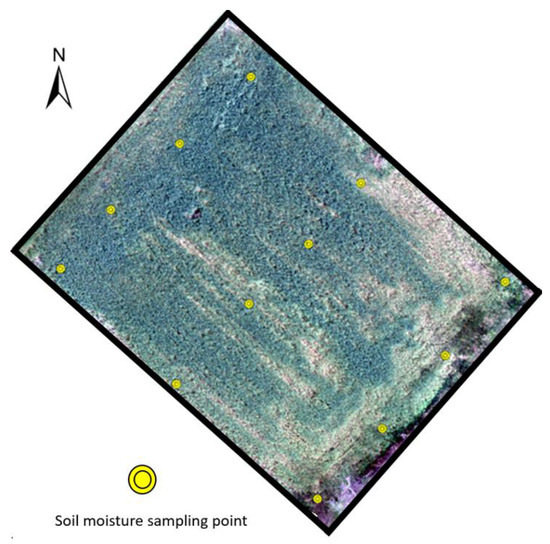
Figure 4.
Detailed spatial locations of the sampling points.
To determine the soil moisture content, all samples were processed using the standard gravimetric oven-drying method. After field collection, each sample was weighed, oven-dried at 105 °C for 24 h, and weighed again. The gravimetric moisture content was calculated as the mass difference divided by the oven-dried mass. This method follows international standards such as ISO 11465:1993 [18] and USDA NRCS [19] soil moisture determination protocols.
The decision to sample soil moisture at a depth of 0–10 cm was based on its relevance to the reflectance properties captured by UAV multispectral sensors, which predominantly detect signals from the soil surface. This depth ensures consistency between ground measurements and image-derived indices [20,21,22]. Moreover, shallow sampling enables rapid data collection and reduces spatial disturbances across multiple locations. While we acknowledge that this layer is sensitive to short-term atmospheric conditions and may not reflect deeper soil moisture, it remains the most responsive layer for remote sensing-based drought monitoring [8,16]. Future studies will consider multi-depth sampling to provide a more comprehensive understanding of soil moisture dynamics.
2.5. Gradient Boosting Regression, GBR
The Gradient Boosting (GB) algorithm can be considered an enhanced iterative form of the Random Forest (RF) algorithm, effectively utilizing the advantages of bagging from RF and the principles of boosting. This combination is used to correct the prediction errors generated by decision trees [23]. The key distinction from RF lies in the inherent interdependence among the decision trees generated in each GB iteration, which contrasts with the independence characteristic of RF. This interdependence helps accelerate the learning gradient in each iteration, thereby effectively reducing computation time. GB is also referred to as additive training, where the prediction result of the previous decision tree is added to the prediction result of the new decision tree , as shown in Equation (5). This combined prediction supports the outcome of the t-th recursion, where the new decision tree must minimize the loss objective function, thus enabling a rapid increase in the learning gradient.
Previous studies have shown that GBR generally outperforms these alternatives in terms of accuracy and stability. For example, Wang et al. [16] demonstrated that GBR achieved an average R2 of 0.87 in soil moisture estimation, outperforming RF (R2 = 0.78) and SVR (R2 = 0.65) under similar UAV-based settings. These results reinforce the choice of GBR in this study as a reliable and effective approach for dryland moisture and yield predictions [16].
2.6. Soil Moisture Content and Wheat Yield Estimation and Correlation Assessment
During each UAV multispectral image acquisition session, 12 soil moisture sampling points were established in Parcel No. 713. For each sampling point, 21 × 21 = 441 index values were extracted, resulting in a total of 441 × 12 = 5292 index values. In this study, 70% of all index values were randomly selected as training samples, while the remaining 30% were used for validation.
For wheat yield estimation, six sampling points within the wheat field were selected during the harvest period. Each sampling point covered an area of 1 m2, and the thousand-grain weight and total grain weight of the wheat ears were measured (Table 3). The correlation between MPDI values and data from these six sampling points was used to train the AI model for wheat yield estimation. For each yield sampling point, 101 × 101 = 10,201 index values were extracted, resulting in a total of 10,201 × 6 = 61,206 index values. Similarly, 70% of the data were randomly selected for model training, and the remaining 30% were used for validation.

Table 3.
Wheat yield sampling data from Parcel No. 713 (2022).
2.7. Research Workflow
Based on the above research procedures, the overall workflow is summarized in Figure 5.

Figure 5.
Research workflow diagram.
3. Results
3.1. Modified Drought Index (MPDI)
In this study, eight sets of multispectral imagery (Table 1) were collected from the Parcel No. 713 wheat field in Kinmen at different growth stages of the wheat crop. These images were paired with in situ soil moisture data collected from 12 sampling locations on the same dates (Table 2) to establish a regression model between the drought index and soil moisture content. The collected multispectral data covered various developmental stages of wheat and ensured the correspondence between image data and field measurements, providing a comprehensive dataset for training the subsequent AI model.
Based on this foundation, the imagery and soil data were imported into a Gradient Boosting Regression (GBR) model for training, with the objective of estimating soil moisture content and deriving a spatial distribution of moisture across the entire field. This output serves as a decision-making reference for determining suitable irrigation timing, water volume, and area in dryland agricultural practices.
However, during the initial regression analysis between raw MPDI values and soil moisture content, the data at most time points exhibited an illogical positive correlation, with only a few dates—19 December 2021, 8 January 2022, and 13 April 2022—showing negative correlations (Table 4). In particular, at the time points with positive correlations, the R values were mostly below 1, indicating low model reliability. These results contradict theoretical expectations, where a higher MPDI value should indicate drier soil and thus lower moisture content [24], implying a negative correlation between the two variables.

Table 4.
Regression analysis between MPDI and soil moisture content (%) of soil samples.
It is inferred that the positive correlation may have resulted from the increasing vegetation coverage during the wheat growth process, which obscures the bare soil and causes the sensor readings in the imagery to be influenced by the crop canopy. This interference makes it difficult to accurately reflect the actual soil moisture status. Only when the wheat has entered the senescence phase, such as on 13 April, with the increased exposure of bare soil, does a reasonable negative correlation reappear.
To address the sensing interference caused by vegetation cover, a modified MPDI formula (Equation (6)) that incorporates the vegetation coverage factor into the original PDI structure is proposed. This adjustment allows for automatic correction when the crop coverage is high.
After recalculating the MPDI for each time point using the modified formula and conducting regression analysis, the results showed reasonable negative correlations at all monitoring points [25,26,27], and all MPDI values were positive (Table 5). Among them, the regression model established for March 11 had the highest value, indicating the best model stability and prediction accuracy.

Table 5.
Regression analysis between and soil moisture content (%) of soil samples.
According to this regression equation, when the soil is completely dry (moisture content = 0%), the estimated MPDI is approximately 3.76. Conversely, when the MPDI is 0, the maximum estimated soil moisture content is about 23%. Therefore, if the actual moisture content exceeds this value, the estimation error may increase significantly and should be interpreted with caution.
3.2. Soil Moisture Estimation and Accuracy Assessment Using the AI Model
To evaluate the performance of the GBR AI model in estimating soil moisture content based on the modified MPDI, 10-fold cross-validation was performed. The dataset was randomly divided into training and validation sets, and the results were averaged across different partitioning scenarios. Cross-validation effectively prevents overfitting or underestimation of errors caused by a biased data distribution, thereby ensuring high model reliability. To ensure the reproducibility of the results, all random splits were performed using a fixed random seed. Moreover, the 10-fold cross-validation was independently repeated ten times with different random seeds, and the final performance metrics were reported as the average of these runs. This approach reduces the influence of sampling variability and ensures the robustness and stability of the model. The final results showed that the GBR model demonstrated consistent accuracy in both the training and validation phases, indicating stability and feasibility in terms of learning and generalization capabilities (Figure 6).
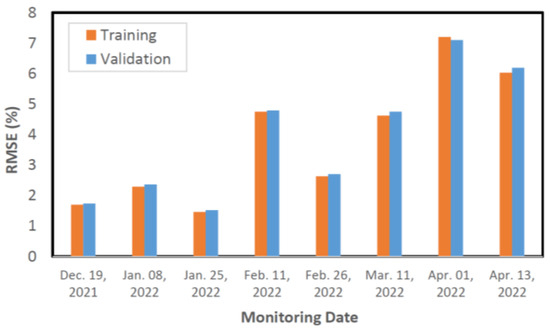
Figure 6.
A comparison chart of the training and validation accuracy of the AI model.
As observed in Figure 6, the predicted values align well with the measured values, showing no significant deviations. This indicates that the GBR model effectively captures the nonlinear relationship between the MPDI and soil moisture content, demonstrating high practical value for real-world agricultural management.
3.3. Soil Moisture Estimation Map
Using the trained GBR model, this study further applied the modified MPDI to estimate pixel-level soil moisture content across the entire wheat field at eight monitoring time points in 2022. The spatial estimation results shown in Table 6 clearly illustrate the spatial variations in soil moisture conditions at different time points.

Table 6.
Soil moisture estimation results for the entire wheat field at eight time points in 2022 based on the .
Although, as shown in Table 5, the data on some dates—such as 11 February and 1 April 2022—exhibited relatively low regression R values, the estimation maps still clearly reveal that the soil moisture content on the southeastern side of the field is generally higher than that on the northwestern side. This pattern is consistent with the actual topographic conditions of the Parcel No. 713 wheat field, indirectly validating the plausibility and consistency of the model’s estimations. This also indicates that even with a weaker regression performance, the model can still accurately capture spatial distribution trends, further confirming that the combination of the GBR model and the modified MPDI is applicable for the field-scale estimation of soil moisture conditions.
3.4. Wheat Yield Estimation
In addition to analyzing soil moisture content, the modified MPDI was also applied to wheat yield prediction. Using yield data from six sampling points in Parcel No. 713 during the 2022 growing season, along with the corresponding MPDI values on the same dates, a GBR model was developed and trained for yield estimation. Each model corresponds to a different image acquisition date, and model performance was evaluated using R values and RMSE to assess accuracy (as shown in Table 7).

Table 7.
R2 values and RMSE of validation samples for actual and estimated wheat yields on each monitoring date.
As shown in Table 7, among all monitoring dates, the model for April 1 demonstrated the best predictive performance, with an value of 0.9186 and an RMSE of 90.41 g/m2, indicating high accuracy in yield estimation for that time point.
To validate the model’s generalization capability, seven multispectral images were also acquired during the 2023 wheat growing season (approximately corresponding to the same time points in 2022). After calculating their MPDI values, they were input into the 2022 yield estimation model to test its predictive accuracy against actual yield measurements (as shown in Table 8).

Table 8.
Wheat yield estimation test results for Parcel No. 713 based on .
4. Discussion
4.1. Relationship Between MPDI and Soil Moisture Content
In the initial regression analysis to estimate soil moisture content using the original Modified Perpendicular Drought Index (MPDI), the results for most time points did not align with theoretical expectations. According to the drought index theory [12], MPDI values should be negatively correlated with soil moisture, since higher drought severity implies lower moisture levels. However, our analysis showed a positive correlation in most cases (see Table 3), suggesting that the original MPDI may not accurately capture drought conditions under vegetated surfaces. This not only deviates from physical interpretation but also highlights the limitations of the original MPDI in agricultural field applications.
The discussion in Section 2.3 regarding the comparison between the MPDI and PDI suggests that the MPDI provides a more accurate representation of vegetation coverage—a finding that is corroborated by the empirical results in this section. Further investigation revealed that the primary cause of this discrepancy is the reduced exposure of bare soil due to crop growth. After wheat sowing, the increasing leaf area index and expanding vegetation cover reduce the visibility of bare soil in multispectral imagery. This weakens the ability to detect soil reflectance from the imagery, resulting in distortions in the PDI calculations and affecting the MPDI’s accuracy in reflecting soil moisture conditions. However, during senescence or pre-harvest stages (e.g., April 13), the vegetation density decreases and more bare soil becomes visible, allowing remote sensing performance to return to normal. As a result, the regression relationship at these times reverts to the expected negative correlation.
To address this issue, this study proposed a revised MPDI formula (Equation (6)) that incorporates a vegetation canopy coverage factor into the index to adjust the denominator term of the distorted PDI. This correction method accounts for the degree of crop interference with image sensing and dynamically adjusts the index value to more accurately reflect the actual soil moisture conditions. After applying the revised MPDI and repeating the regression analysis (Table 4), the data displayed negative correlations at all monitoring time points, eliminating the previously observed unrealistic positive correlations and low reliability. This demonstrates the theoretical soundness and practical feasibility of the proposed correction and provides a foundation for drought monitoring applications.
Notably, according to the regression result for 11 March, when the MPDI equals 0, the estimated maximum soil moisture content is 23%, and when the soil is completely dry (moisture content = 0%), the MPDI is approximately 3.76. This provides a concrete estimation range, which can be used as a practical reference for setting drought warnings and irrigation thresholds.
This study used the MPDI value as an indicator for estimating soil moisture content, which is valuable for real-time irrigation scheduling and crop management and is consistent with the viewpoint proposed by Peiwen Yao et al. in 2025 [28].
4.2. The Feasibility of Applying the AI Model for Soil Moisture Estimation
Based on the modified MPDI and combined with Gradient Boosting Regression (GBR), the AI model developed in this study demonstrated high consistency and accuracy in estimating soil moisture content. Ten-fold cross-validation was conducted, which showed that model learning was stable during the training phase while effectively avoiding overfitting and the associated estimation bias.
As shown in Figure 6, there is no significant gap between the training and validation accuracy, indicating that the GBR model is capable of capturing the nonlinear relationship between the MPDI and soil moisture content. Furthermore, the spatial distribution patterns presented in the estimation maps (Table 6) align well with the actual topographic conditions of Parcel No. 713. Specifically, the soil moisture content in the southeastern part of the field is noticeably higher than that in the northwestern part, consistent with expected rainfall runoff and water accumulation behavior due to the terrain. Therefore, even on dates when the regression values were relatively low—such as 11 February and 1 April—the overall spatial estimation maps still showed a coherent and reasonable distribution pattern. This validates the practical applicability and topographic sensitivity of the AI model developed in this study.
4.3. Optimal Timing for Wheat Yield Prediction
In addition to estimating soil moisture, this study also explored the relationship between the MPDI and wheat yield. Using wheat ear measurement data from six sampling points in 2022, yield prediction models were established based on MPDI values obtained on different dates, with their predictive performance evaluated using R values and RMSE (Table 5).
The results demonstrate that the model based on data from 1 April 2022 yielded the highest performance, with an value of 0.9186 and the lowest prediction error. This finding implies that the maturity stage of wheat, particularly after the completion of irrigation, presents the most stable spectral reflectance characteristics. At this point, the crop has completed its major physiological development, and the spectral signals captured are more directly associated with the final yield. Consequently, this stage represents an optimal window for accurate yield estimation.
To assess the practicality and cross-year applicability of the model, MPDI values calculated from seven multispectral images acquired in 2023 were input into the 2022 yield prediction model for testing. The results showed that when using MPDI values from around 31 March 2023, with the model trained on data from 1 April 2022, the yield prediction accuracy reached 95.33% (Table 8), significantly outperforming predictions from other time points and closely aligning with the actual yield of 760 kg reported by the Kinmen County Government.
These findings strongly indicate that the optimal timing for yield estimation is immediately after irrigation and at the onset of the maturity stage, when imagery can most accurately reflect the crop’s yield potential. Furthermore, the MPDI has proven to be not only effective for soil moisture estimation but also a valuable auxiliary indicator for crop yield prediction, suggesting its potential for integration into efficient agricultural monitoring systems in the future.
4.4. Application Value and Future Development
Based on the above analysis, the MPDI correction approach proposed in this study, combined with AI learning techniques, establishes an agricultural monitoring method suitable for dryland environments. This method not only demonstrates theoretical innovation but also shows significant practical value. The research outcomes can be widely applied in the following areas:
- Irrigation Decision Support:
The model can provide timely, site-specific, and quantity-appropriate irrigation recommendations across different regions and time periods, effectively improving water use efficiency.
- 2.
- Adaptation to Extreme Climate:
In response to droughts and highly variable rainfall caused by climate change, the model can serve as a basis for agricultural adaptation strategies.
- 3.
- Crop Yield Management:
By integrating the multi-temporal MPDI with AI models, crop yield can be predicted at different growth stages, assisting farmers in planning sales and logistics in advance.
- 4.
- Future Expansion Potential:
This model can be extended to other crop types or regions and further integrated with real-time UAV or satellite imagery to develop a real-time agricultural monitoring platform.
While the current study demonstrates the feasibility and accuracy of the proposed model within a single dryland wheat field, its spatial generalizability across different agro-environmental contexts remains to be tested. Future work will involve applying the model to additional sites with diverse soil types and climatic conditions, such as clayey loam soils or areas with higher precipitation variability. These validations will further assess the robustness and transferability of the modified MPDI and GBR framework and support broader deployment in regional-scale agricultural monitoring systems.
It is important to note that soils are inherently three-dimensional, and this study focused solely on the surface layer (0–10 cm). While this depth aligns well with the sensing range of UAV-based multispectral imagery and captures early-stage root zone activity, it may not fully represent subsurface moisture conditions, particularly during middle to late growth stages. Crops such as wheat often extend their roots to depths of 30–60 cm, where significant soil–plant water exchange occurs. Therefore, future model refinements should incorporate multi-depth soil moisture sampling and consider the development of three-dimensional estimation models. This would enable more accurate assessment of water availability across the full root zone and improve model transferability to other crops and soil conditions.
5. Conclusions
This study focused on a wheat field located at Parcel No. 713 in Kinmen, integrating multispectral remote sensing imagery, a modified version of the Modified Perpendicular Drought Index (MPDI), and an AI model based on Gradient Boosting Regression (GBR). A comprehensive method for estimating soil moisture and crop yield in dryland agriculture was developed. The results were validated and found to be highly accurate and practically applicable. The main conclusions are as follows:
- The Modified MPDI Demonstrates Validity and Stability
The original MPDI showed unreasonable positive correlations with soil moisture content during the middle to late stages of crop growth due to spectral interference caused by vegetation cover. To resolve this issue, this study proposed a modified version of the MPDI (Equation (6)) that incorporates a vegetation coverage factor. This successfully corrected the MPDI–soil moisture relationship to a negative correlation at all monitoring time points and ensured that all MPDI values remained positive, meeting both theoretical and practical expectations. The regression model established on March 11 performed best, offering a clear estimation range and interpretability of the index, making it suitable for practical irrigation decision support.
- The AI Model Effectively Predicts Soil Moisture Distribution
Ten-fold cross-validation demonstrated the GBR model’s stability, with consistent accuracy between the training and validation phases. This confirmed the model’s ability to capture the nonlinear relationship between the MPDI and soil moisture content. Using the model, soil moisture distribution across the wheat field was estimated for eight time points in 2022. The results revealed a clear geographical trend—higher moisture in the southeastern region and lower moisture in the northwest—which aligns with the actual topographic conditions. This indicates that the model is both spatially sensitive and accurate, making it suitable for monitoring field-scale moisture variability.
- The Optimal Timing for Wheat Yield Prediction Is Between Irrigation and Maturity
Yield prediction results indicated that the GBR model built using data from 1 April 2022 (R = 0.9186) had the best performance. This suggests that the period following irrigation and leading into crop maturity is the most suitable for accurate yield prediction, as spectral information at this stage best reflects the final yield potential. When applied to imagery acquired around 31 March 2023, the model achieved a prediction accuracy of 95.33%, closely matching the official yield figures reported by the Kinmen County Government. This demonstrates the model’s cross-year applicability and reliability.
In summary, the proposed MPDI modification and AI prediction model can be effectively applied to estimate both soil moisture and wheat yield in dryland fields. It also provides a valuable reference for determining the optimal irrigation timing and area, enhancing water use efficiency and crop productivity. The method is reproducible and holds potential for broader applications for other regions or crop types. Moreover, it can be integrated with UAVs or satellite imagery to support large-scale, automated agricultural monitoring—contributing to climate resilience and the advancement of smart agriculture.
Author Contributions
Conceptualization, T.-C.S.; Methodology, T.-C.S.; Formal analysis, T.-C.S. and T.-C.W.; Investigation, H.-J.C.; Writing—original draft, T.-C.W. All authors have read and agreed to the published version of the manuscript.
Funding
This research was funded by the National Science and Technology Council (NSTC), Taiwan, grant number NSTC112-2410-H-507-004.
Data Availability Statement
The raw data supporting the conclusions of this article will be made available by the authors on request.
Conflicts of Interest
The authors declare no conflict of interest.
References
- Vogel, E.; Donat, M.G.; Alexander, L.V.; Meinshausen, M.; Ray, D.K.; Karoly, D.J.; Meinshausen, N.; Friele, K. The effects of climate extremes on global agricultural yields. Environ. Res. Lett. 2019, 14, 054010. [Google Scholar] [CrossRef]
- D’Odorico, P.; Chiarelli, D.D.; Rosa, L.; Bini, A.; Zilberman, D.; Rulli, M.C. The global value of water in agriculture. Proc. Natl. Acad. Sci. USA 2020, 117, 21985–21993. [Google Scholar] [CrossRef] [PubMed]
- Abdelhaleem, F.S.; Basiouny, M.; Ashour, E.; Mahmoud, A. Application of remote sensing geographic information systems in irrigation water management under water scarcity conditions in Fayoum Egypt. J. Environ. Manag. 2021, 299, 113683. [Google Scholar] [CrossRef] [PubMed]
- Food and Agriculture Organization of the United Nations. World Reference Base for Soil Resources: International Soil Classification System for Naming Soils and Creating Legends for Soil Maps, 4th ed.; FAO: Rome, Italy, 2022. [Google Scholar]
- Huang, Y.-C.; Nguyen, K.A.; Chen, W. Soil erosion on Kinmen (Quemoy) Island. SSRN Electron. J. 2024, 1, 22. [Google Scholar] [CrossRef]
- Chen, L.; Xing, M.; He, B.; Wang, J.; Xu, M.; Song, Y.; Huang, X. Estimating soil moisture over winter wheat fields during growing season using RADARSAT-2 data. Remote Sens. 2022, 14, 2232. [Google Scholar] [CrossRef]
- Shoshany, M.; Spond, H.; Bar, D.E. Overcast versus clear-sky remote sensing: Comparing surface reflectance estimates. Int. J. Remote Sens. 2019, 40, 6610–6630. [Google Scholar] [CrossRef]
- Lu, F.; Sun, Y.; Hou, F. Using UAV visible images to estimate the soil moisture of steppe. Water 2020, 12, 2334. [Google Scholar] [CrossRef]
- Ghulam, A.; Qin, Q.; Zhan, Z. Designing of the perpendicular drought index. Environ. Geol. 2006, 52, 1045–1052. [Google Scholar] [CrossRef]
- Farhan, I.A.; Al-Bakri, J. Detection of a real time remote sensing indices and soil moisture for drought monitoring and assessment in Jordan. Open J. Geol. 2019, 9, 1048–1068. [Google Scholar] [CrossRef]
- Ghulam, A.; Qin, Q.; Teyip, T.; Li, Z.-L. Modified perpendicular drought index (MPDI): Areal-time drought monitoring method, I.S.P.R.S.J. Photogramm. Remote Sens. 2007, 62, 150–164. [Google Scholar] [CrossRef]
- Shahabfar, A.; Ghulam, A.; Eitzinger, J. Drought monitoring in Iran using the perpendicular drought indices. Int. J. Appl. Earth Obs. Geoinf. 2012, 18, 119–127. [Google Scholar] [CrossRef]
- Xu, D.; Guo, X. A study of soil line simulation from Landsat images in mixed grassland. Remote Sens. 2013, 5, 4533–4550. [Google Scholar] [CrossRef]
- Yoshioka, H.; Miura, T.; Demattê, J.A.M.; Batchily, K.; Huete, A.R. Derivation of soil line influence on two-band vegetation indices and vegetation isolines. Remote Sens. 2009, 1, 842–857. [Google Scholar] [CrossRef]
- Fox, G.A.; Sabbagh, G.J.; Searcy, S.W.; Yang, C. An automated soil line identification routine for remotely sensed images. Soil Sci. Soc. Am. J. 2004, 68, 1326–1331. [Google Scholar] [CrossRef]
- Wang, J.; Sha, J.; Liu, R.; Ren, S.; Zhao, X.; Liu, G. The study of various regression models establishment to identify farmland soil moisture content at different depths using unmanned aerial vehicle multispectral data: A case in North China Plain. Water 2024, 16, 807. [Google Scholar] [CrossRef]
- Koenker, R.; Bassett, G. Regression quantiles. Econometrica 1978, 46, 33–50. [Google Scholar] [CrossRef]
- ISO 11465:1993; Soil Quality—Determination of Dry Matter and Water Content on a Mass Basis—Gravimetric Method. International Organization for Standardization: Geneva, Switzerland, 1993.
- USDA NRCS. Soil Survey Manual; United States Department of Agriculture, Natural Resources Conservation Service: Washington, DC, USA, 2017.
- Zhao, J.; Peng, H.; Yang, J.; Huang, R.; Huo, Z.; Ma, Y. Response of winter wheat to different drought levels based on Google Earth Engine in the Huang-Huai-Hai Region, China. Agric. Water Manag. 2024, 292, 108662. [Google Scholar] [CrossRef]
- Yuan, H.; Liang, S.; Gao, Y.; Gao, Y.; Lian, X. Experimental study on estimating bare soil moisture content based on UAV multi-source remote sensing. Geocarto Int. 2025, 40, 2448985. [Google Scholar] [CrossRef]
- Hernandez, A.; Duarte, E.; Porter, P.; Brecht, H. Spatial predictions of soil moisture across a longitudinal gradient in semiarid ecosystems using UAV and RGB sensors. Geocarto Int. 2025, 40, 2461523. [Google Scholar] [CrossRef]
- Natekin, A.; Knoll, A. Gradient boosting machines: A tutorial. Front. Neurorobot. 2013, 7, 21. [Google Scholar] [CrossRef]
- Zhang, J.; Zhang, Q.; Bao, A.; Wang, Y. A new remote sensing dryness index based on the near-infrared and red spectral space. Remote Sens. 2019, 11, 456. [Google Scholar] [CrossRef]
- Li, Z.; Tan, D. The second modified perpendicular drought index (MPDI1): A combined drought monitoring method with soil moisture and vegetation index. J. Indian Soc. Remote Sens. 2013, 41, 873–881. [Google Scholar] [CrossRef]
- Lu, X.; Zhao, H.; Huang, Y.; Liu, S.; Ma, Z.; Jiang, Y.; Zhang, W.; Zhao, C. Generating daily soil moisture at 16 m spatial resolution using a spatiotemporal fusion model and modified perpendicular drought index. Sensors 2022, 22, 5366. [Google Scholar] [CrossRef] [PubMed]
- Tao, L.; Ryu, D.; Western, A.; Boyd, D. A new drought index for soil moisture monitoring based on MPDI-NDVI trapezoid space using MODIS data. Remote Sens. 2021, 13, 122. [Google Scholar] [CrossRef]
- Yao, P.; Fan, H.; Wu, Q. Optimal drought index selection for soil moisture monitoring at multiple depths in China’s agricultural regions. Agriculture 2025, 15, 423. [Google Scholar] [CrossRef]
Disclaimer/Publisher’s Note: The statements, opinions and data contained in all publications are solely those of the individual author(s) and contributor(s) and not of MDPI and/or the editor(s). MDPI and/or the editor(s) disclaim responsibility for any injury to people or property resulting from any ideas, methods, instructions or products referred to in the content. |
© 2025 by the authors. Licensee MDPI, Basel, Switzerland. This article is an open access article distributed under the terms and conditions of the Creative Commons Attribution (CC BY) license (https://creativecommons.org/licenses/by/4.0/).
